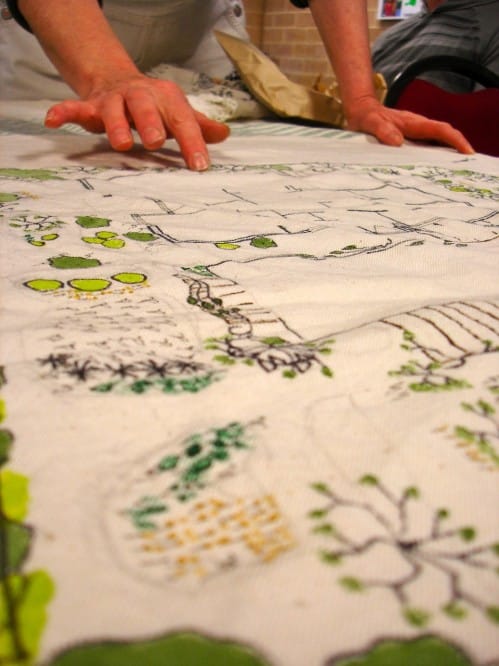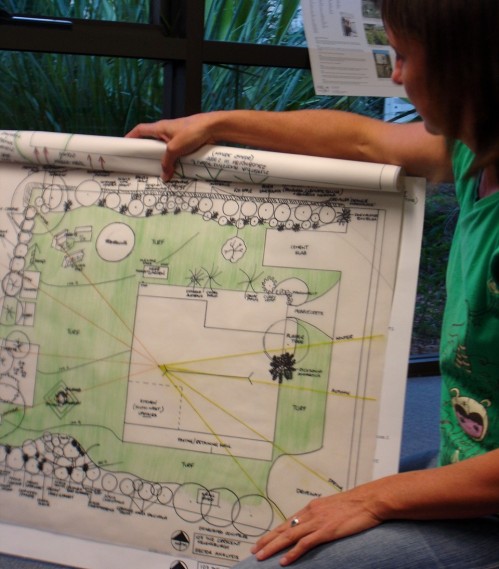The latest batch of Milkwood permaculture design students are currently hard at it in Sydney, taking their Permaculture Design Certificate part-time with the fabulous Alexia Martinez. I thought I’d share some of their latest permaculture designs…
These designs are all the student’s first full permaculture design, undertaken using a place they know well as the site. This design exercise is all about working with what you’ve got, both good and bad. Bring on the shady patios, the hot brick walkways, and the unused verges. It’s all potential for abundance, with the help of good planning and design… 
Hooray for relative location, sector analysis, observation and interaction. So exciting to know another bunch of permaculture designers will soon be out there in the wide and wonderful fabric of Sydney. This can only be a good thing for resilient futures in this fine city!
If you’d like to learn more about permaculture design and how to retrofit (or design from scratch) a site that provides for your needs and doesn’t cost the earth, our next two Permaculture Design Certificates are happening!
- Urban Permaculture Design Certificate: Sydney: July 2012
- Permaculture Design Certificate: Milkwood Farm (Mudgee): November 2012
… More about permaculture design at Milkwood



























I really love the first photo of the quail enclosure. What a fantastic idea and super practical. With the problems I have with codling moth I could see that used in my garden very easily. Best of luck to all the students.
I love looking at these kinds of visual designs! They’re very artistic.
Someone could make a fantastic coffee table book from a collection of double-page permaculture plans, all from different cultures, climates, artists, etc. If any permaculture entrepreneur out there does it, let me know and I’ll buy a copy!
Damian, I have a feeling that book-producing somebody might be you! This is the era of e-publishing. If you make sure you use observation, get increments of feedback, start small and think big, your venture would work. Get in touch with Rico, she has been making Japanese permaculture illustrated calendars for years now. She will give you hints for making it a successful project. How gorgeous and diverse is this Japanese-flavored creativity: http://www1.parkcity.ne.jp/permaculture/staff/index.html How gorgeous and diverse are we?? Alexia, it looks like magic, what you have caused on this course. But its not magic, its just Permaculture, and all… Read more »
I like the 5th one down. It hints at the possibilities of marrying western landscape architecture with edible plants. People new to Permaculture (in the religious zealot stage) are often very careful to be culturally appropriate when discussing the approach to overseas aid projects. When it comes to their own country though, without saying it in these words, they are basically taking the attitude of “You’re an arsehole and are killing the earth with your f*$#^ing lawn and roses”. They then present an alternative which they would like people to adopt which is about as nuanced as a 3 year… Read more »
Love these designs. As someone currently studying my Diploma of lanscape design, I would love to be able to integrate sustainable and permaculture principals but we are unable to access these units because our lecturer is mainstream (uninterested in permaculture…only profit and design). Working with AutoCad has given us an insight (husband is studying too) about design that your students are learning amazingly well on their own. Perhaps we are wasting our money and time and should just head up to Sydney and do a permaculture course! That’s the way that we want to eventuate anyway. Love your students work… Read more »
Gosh. Wow!
The Victorian gardens integrated with permaculture principles is an awesome design that would help bring permaculture more mainstream in ‘conventional’ society where heritage is strong – I think Europe for instance – and where wavy paths, spirals and other organic patterns are considered weird!
There were some rather difficult sites to design and it’s always a marvel to see how permaculture can bring resilience, hope and abundance wherever it’s applied.